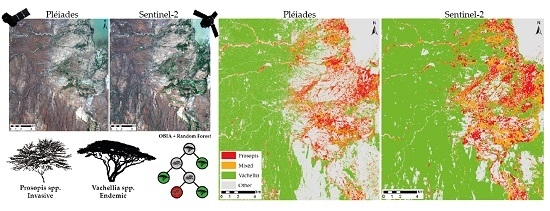1
Institute for Surveying, Remote Sensing and Land Information, University of Natural Resources and Life Sciences, Vienna (BOKU), Peter Jordan Str. 82, A-1190 Vienna, Austria
2
Kenya Forestry Research Institute (KEFRI), Baringo Sub Centre, P.O. BOX 57-30403, Marigat, Kenya
3
Faculty of Arts and Humanities, Department of Geography, Chuka University, P.O. Box 109-60400, Chuka, Kenya
4
Centre for Development and Environment, University of Bern, Hallerstrasse 10, CH-3012 Bern, Switzerland
*
Author to whom correspondence should be addressed.
Academic Editors: Lars T. Waser and Prasad S. Thenkabail
Received: 9 September 2016 / Revised: 20 December 2016 / Accepted: 2 January 2017 / Published: 16 January 2017
(This article belongs to the Special Issue First Experiences with European Sentinel-2 Multi-Spectral Imager (MSI))
Abstract
Prosopis was introduced to Baringo, Kenya in the early 1980s for provision of fuelwood and for controlling desertification through the Fuelwood Afforestation Extension Project (FAEP). Since then, Prosopis has hybridized and spread throughout the region. Prosopis has negative ecological impacts on biodiversity and socio-economic effects on livelihoods. Vachellia tortilis, on the other hand, is the dominant indigenous tree species in Baringo and is an important natural resource, mostly preferred for wood, fodder and charcoal production. High utilization due to anthropogenic pressure is affecting the Vachellia populations, whereas the well adapted Prosopis—competing for nutrients and water—has the potential to replace the native Vachellia vegetation. It is vital that both species are mapped in detail to inform stakeholders and for designing management strategies for controlling the Prosopis invasion. For the Baringo area, few remote sensing studies have been carried out. We propose a detailed and robust object-based Random Forest (RF) classification on high spatial resolution Sentinel-2 (ten meter) and Pléiades (two meter) data to detect Prosopis and Vachellia spp. for Marigat sub-county, Baringo, Kenya. In situ reference data were collected to train a RF classifier. Classification results were validated by comparing the outputs to independent reference data of test sites from the “Woody Weeds” project and the Out-Of-Bag (OOB) confusion matrix generated in RF. Our results indicate that both datasets are suitable for object-based Prosopis and Vachellia classification. Higher accuracies were obtained by using the higher spatial resolution Pléiades data (OOB accuracy 0.83 and independent reference accuracy 0.87–0.91) compared to the Sentinel-2 data (OOB accuracy 0.79 and independent reference accuracy 0.80–0.96). We conclude that it is possible to separate Prosopis and Vachellia with good accuracy using the Random Forest classifier. Given the cost of Pléiades, the free of charge Sentinel-2 data provide a viable alternative as the increased spectral resolution compensates for the lack of spatial resolution. With global revisit times of five days from next year onwards, Sentinel-2 based classifications can probably be further improved by using temporal information in addition to the spectral signatures. View Full-Text
Keywords: Prosopis; Vachellia; object-based classification; Random Forest (RF); Sentinel-2; Pléiades; invasive plant species; East Africa
▼ Figures
This is an open access article distributed under the Creative Commons Attribution License which permits unrestricted use, distribution, and reproduction in any medium, provided the original work is properly cited. (CC BY 4.0).
For further details log on website :
http://www.mdpi.com/2072-4292/9/1/74






No comments:
Post a Comment